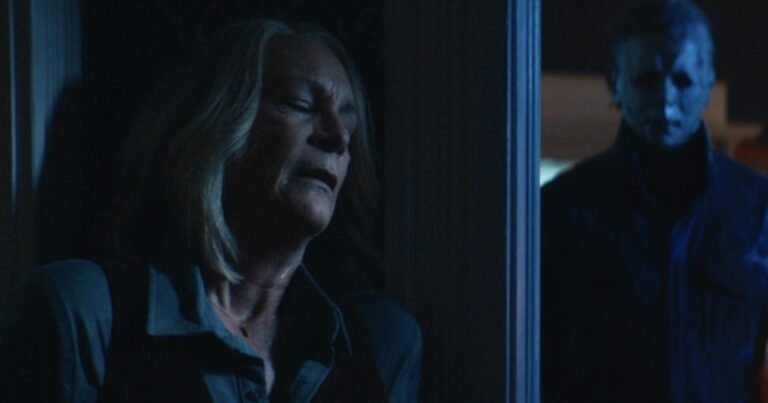Halloween Ends (USA | 111 minutes | David Gordon Green)
Since seeing Halloween Ends, purportedly the final chapter in director David Gordon Green’s reboot of the iconic slasher franchise, I’ve oscillated between dismissing it as entertainingly lousy, and viewing it as a work of operatically-pitched satiric genius. Truth be told, it kinda feels like both at once, and therein lies much of its cockeyed charm. Whether you succumb to that charm, however, is another story.
Ends picks up three years after the town of Haddonfield opened up a can of whoop-ass on masked serial killer Michael Myers, only to have the big lug disappear without a trace. A genuinely tense, ostensibly unrelated opening sorta-flashback introduces Corey Cunningham (Rohan Campbell), a college-bound kid whose future gets decimated by a tragedy for which he’s scapegoated.
Flash forward to the present day, where veteran survivor/final girl Laurie Strode (Jamie Lee Curtis) seems to have finally come to terms with the PTSD and addictions spawned by her way-too-close encounters with Boogeyman Michael back in the day. Her granddaughter Allyson (Andi Matichak) works at a local doctor’s office and lives with Laurie in her new house, while Laurie gravitates towards a possible romance with local deputy Frank Hawkins (Will Patton).
Aided by her matchmaking grandmother, Allyson meets cute with Corey, who’s now shunned by most of the townsfolk and tethered inexorably to the dead end of suburbia. Bullied and despondent, he’s vulnerable to bad influences. And when he stumbles into an encounter with none other than Haddonfield’s Number One Boogeyman in the sewer tunnels underneath the town, Corey becomes a total Michael Myers stan—in ways that could lead to a new serial killer on the block.
This modern trilogy started in promising fashion in 2018 with Halloween (zero originality points for the title). It ignored the other nine sequels that followed John Carpenter’s world-changing 1978 original, essentially picking up four decades after psychotic boogeyman Michael Myers’s initial killing spree. And while it wasn’t perfect by a long stretch, the 2018 Halloween made a game attempt to drag the franchise into the 21st century. Best of all, it offered Jamie Lee Curtis a welcome opportunity to really sink her teeth into Laurie’s warts-and-all past and present. Director Green also proved that he had the goods when it came to staging horror set pieces. And yes, horror civilians, that stuff matters.
Any guarded optimism, however, got pretty thoroughly crapped on by the 2021 followup, Halloween Kills. The screenplay by Green, Danny McBride, and Scott Teems saw its clumsy sermonizing about mob brutality torpedoed by some of the most frustratingly bad writing and characterization to ever surface in a horror franchise.
On the face of it, Halloween Ends shares a lot of Kills’ faults. It’s rife with interesting ideas that almost uniformly fall by the wayside or get executed with optimal goofiness; and after that solid semi-cold open it rapidly descends squarely into abject silliness and stupidity. Somehow, though, it manages to sidestep generating the same throbbing-toothache painful badness that informed Halloween Kills.
The distinction surfaces early on. To quote poet laureate Weird Al Yankovic, Halloween Ends dares to be stupid. It embraces its inanity with zero-fucks-given gusto, and plays so much like parody, it’s gotta be intentional.
Corey and Allyson fall madly in love and tool around Haddonfield on Corey’s motorcycle like leads in an ultra-cheesy ‘80s teen angst drama. This leads to overheated squabbles between Allyson and her grandmother that smack of an overheated, giggle-worthy mutation of every stupid teenage-rebel drama ever made. With a few isolated exceptions, every character in the movie represents a cartoonish archetype that goes from zero to over-over-the-top on a dime.
Interspersed with the silliness, here’s some finger-wagging about the unhealthiness of bullying (for both the bullied and the bully). And the interactions between Laurie and her would-be paramour Frank click with such surprising intelligence and quiet sweetness, you’ll swear they sauntered in from a different film. That duality of great ideas/moments getting lost in the execution induced irritation in the previous installment.
Here it’s strangely surreal, as though a few healthy, tasty vegetables ended up in a heaping bowl of greasy but guiltily yummy store-brand barbecue potato chips. And there’s no denying the sadistic glee in the kill scenes (I refuse to spoil the howlingly funny and crudely clever DJ booth scene that spices up Act Two).
You’ll get no spoilers from this corner as to whether or not Evil Dies Tonight (to quote Halloween Kills’ dopey but memorable tagline). But it sullies nothing to state that the big denouement’s shot in hilariously hammy slow-motion like some modern-day white-trash attempt at a Game of Thrones funeral procession scene—only with more blood and viscera to cap it off. It also says something that the preview audience greeted the big payoff with gales of laughter, and spontaneous applause.
In the end (no pun intended), how you perceive Halloween Ends’ shaggy strangeness stands as the big litmus test here. If you think it’s a pompous attempt to make a good movie that fails in annoying fashion, you’ll likely hate it, and a lot of fans do.
From this cramped perspective, though, its feverish, overwrought pitch felt quite deliberate, and it leans into that delirium eagerly. That may not make it good in the traditional sense, but it renders it funnier, more subversive, and way more entertaining than it has any right to be.
Halloween Ends is now playing in theaters nationwide, and is also streaming on Peacock. Header image courtesy Universal/Blumhouse.




